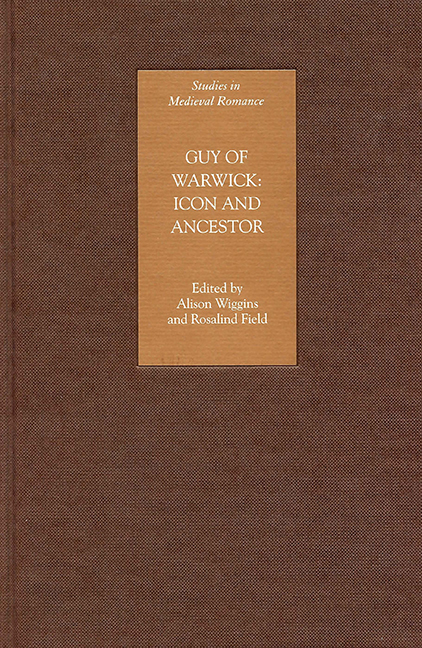Book contents
- Frontmatter
- Contents
- Illustrations
- Contributors
- Abbreviations
- Dedication
- Editorial Introduction: Namoore of this! How to read Guy of Warwick and why
- 1 Gui de Warewic at Home and Abroad: A Hero for Europe
- 2 Gui de Warewic in its Manuscript Context
- 3 Guy of Warwick as a Translation
- 4 From Gui to Guy: The Fashioning of a Popular Romance
- 5 The Manuscripts and Texts of the Middle English Guy of Warwick
- 6 The Speculum Guy de Warwick and Lydgate's Guy of Warwick: The Non-Romance Middle English Tradition
- 7 An Exemplary Life: Guy of Warwick as Medieval Culture-Hero
- 8 The Visual History of Guy of Warwick
- 9 ‘In her owne persone semly and bewteus’: Representing Women in Stories of Guy of Warwick
- 10 Of Dragons and Saracens: Guy and Bevis in Early Print Illustration
- 11 Guy of Warwick and The Faerie Queene, Book II: Chivalry Through the Ages
- 12 Guy as Early Modern English Hero
- Appendix: Synopsis of the Guy of Warwick narrative
- Index
Editorial Introduction: Namoore of this! How to read Guy of Warwick and why
Published online by Cambridge University Press: 24 October 2017
- Frontmatter
- Contents
- Illustrations
- Contributors
- Abbreviations
- Dedication
- Editorial Introduction: Namoore of this! How to read Guy of Warwick and why
- 1 Gui de Warewic at Home and Abroad: A Hero for Europe
- 2 Gui de Warewic in its Manuscript Context
- 3 Guy of Warwick as a Translation
- 4 From Gui to Guy: The Fashioning of a Popular Romance
- 5 The Manuscripts and Texts of the Middle English Guy of Warwick
- 6 The Speculum Guy de Warwick and Lydgate's Guy of Warwick: The Non-Romance Middle English Tradition
- 7 An Exemplary Life: Guy of Warwick as Medieval Culture-Hero
- 8 The Visual History of Guy of Warwick
- 9 ‘In her owne persone semly and bewteus’: Representing Women in Stories of Guy of Warwick
- 10 Of Dragons and Saracens: Guy and Bevis in Early Print Illustration
- 11 Guy of Warwick and The Faerie Queene, Book II: Chivalry Through the Ages
- 12 Guy as Early Modern English Hero
- Appendix: Synopsis of the Guy of Warwick narrative
- Index
Summary
Guy of Warwick is England's other Arthur, his legend England's most successful medieval romance and so this book considers the Guy tradition as the quintessential popular romance of England, and one that demonstrates the reception of romance working in and beyond medieval culture to a unique degree. The medieval, as a space for fantasy, imagination, or nostalgia, is everywhere – reflected in images and poetry and, in our own time, in film, novels, heritage, music, on the internet, in advertising, and in street names. It is our belief that scholarship has a particular responsibility to take seriously the investigation of sources, purposes, effects, and exploitation.
The Guy tradition is peculiar for its expansiveness, complexity, and for the diversity of its materials, which span different languages, media, chronological periods, and social categorizations. In order to deal with such range and variety of the materials many of the contributors to this volume, although they largely belong to English departments, draw on techniques from other disciplines – from history, art history, French, linguistics, or manuscript studies. Only by allocating aspects of the tradition to scholars with these kinds of specialist interests and areas of knowledge and expertise has it been possible to maintain the sharp scholarly focus throughout. Such explorations developing different responses to shared questions are important aspects of the interdisciplinary nature of this volume. But there is more to it than this: the interdisciplinary conception and ambition behind this book has enriched and added value to the whole project. The original idea for the volume came during a post-LOMERS dinner one wet February evening in 2004. The dimly lit basement of Pizza Paradiso on Store Street has become something of a hotspot for London medievalists, bleary eyed from a day in the library or the lecture theatre and eager to meet, engage in discussion, exchange ideas, and entertain visiting speakers. True to the spirit of this LOMERS rendezvous, we set out to foster more conversations about Guy of Warwick, to bring more ideas to the table.
- Type
- Chapter
- Information
- Guy of Warwick: Icon and Ancestor , pp. xv - xxiiPublisher: Boydell & BrewerPrint publication year: 2007



